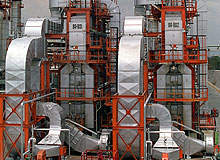
The Miguel Hidalgo refinery is located in Tula in the Hidalgo state of Mexico. Located about 150km from Mexico City, the refinery is owned and operated by Mexican oil company Pemex. The refinery was built in March 1976 and put into operation in 1977.
The initial processing capacity of the refinery was 150,000 barrels per day (bpd). The refinery currently has a processing capacity of 320,000bpd. It supplies motor fuels to various states of Mexico including Hidalgo, Morelos, Queretaro, Celaya and Guerrero.
Extension
In March 2010, Pemex awarded an $800m contract to Saipem to construct a desulphurisation unit and an amine regeneration unit at the refinery. The contract also includes construction of similar units at Pemex’s Antonio M. Amor refinery in Salamanca, Mexico. The scope of work for Saipem includes engineering, procurement and construction (EPC) of the two units.
Saipem will be responsible for commissioning and testing the units. The company will also construct related auxiliary systems at the refinery. The two units are expected to be completed in 38 months.
The two units are being constructed to reduce sulphur content of the gasoline produced at the refinery. Sulphur content in gasoline needs to be reduced to meet Mexican environmental regulations and also mitigate harmful emissions.
Construction and infrastructure
In 1994, the refinery’s Methyl tert-butyl ether (MTBE), tertiary amyl methyl ether (TAME) and catalytic units became operational.
In 1995, Fagioli PSC was contracted to erect four heavy oil reactors at the refinery. Each reactor weighed 1,310t and was 45m long with a diameter of 6m. Scope of work for Fagioli included raising the reactors vertically, rotating them through 1800 and placing them over their foundations.
Fagioli used 6m high Tower Lift supports, a pair of 23m long box beams and L600 lifting jacks to perform the lift operations. The L600 lifting jacks were supported by a traversing carriage which was, in turn, supported by 16 Hillman Rollers. The reactor top lifting lugs were connected to a 350mm diameter steel pin, which helped the lifting jacks lift them into position. The four reactors were placed into position in 10 days.
The heavy wastes unit (H-Oil) of the refinery became operational in 1999.
In 2007, Pemex launched a programme to cut 49,000t/y of greenhouse gas emissions from the boilers of the refinery. The company signed an agreement to trade carbon credits for emissions with Carbon Solutions, an environmental consulting company.
Technology
In October 2003, Emerson Process Management, a unit of Emerson, was awarded a $3.9m contract for automating the alkylation plant of the refinery. Emerson used its PlantWeb architecture to automate the alkylation plant. The plant produces high-octane gasoline at the refinery.
The PlantWeb technology was selected due to its easy configuration and ability to provide better plant availability. By installing the technology, Pemex was able to provide authorised personnel access to a range of information regardless of their physical location. The personnel can access real-time information about various devices and equipment installed at the refinery.
The PlantWeb technology also includes a DeltaV digital automation system and AMS Suite predictive maintenance software. The technology communicates with field devices installed at the refinery through the Foundation fieldbus technology.
Contractors
ABB Automation won a contract in October 2000 to supply control and instrumentation systems to the refinery. The $4.2m contract was part of a refinery modernisation programme. ABB modernised the control system, process analysers and field instrumentation of the refinery under the contract. The new systems are used for data acquisition and control.
ECIS Group was responsible for the procurement of purging and flushing systems and other bulk materials.
Hanol Technology provided heat transfer design services for the refinery in 2000.
AICO Corporation provided inspection and technical services for the refinery between September 2000 and December 2001.

